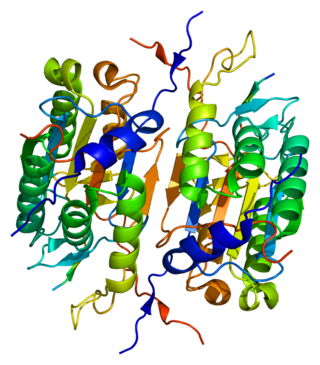
Caspase-1/Interleukin-1 converting enzyme (ICE) is an evolutionarily conserved enzyme that proteolytically cleaves other proteins, such as the precursors of the inflammatory cytokines interleukin 1β and interleukin 18 as well as the pyroptosis inducer Gasdermin D, into active mature peptides. It plays a central role in cell immunity as an inflammatory response initiator. Once activated through formation of an inflammasome complex, it initiates a proinflammatory response through the cleavage and thus activation of the two inflammatory cytokines, interleukin 1β (IL-1β) and interleukin 18 (IL-18) as well as pyroptosis, a programmed lytic cell death pathway, through cleavage of Gasdermin D. The two inflammatory cytokines activated by Caspase-1 are excreted from the cell to further induce the inflammatory response in neighboring cells.

NLR family pyrin domain containing 3 (NLRP3), is a protein that in humans is encoded by the NLRP3 gene located on the long arm of chromosome 1.

Caspase 2 also known as CASP2 is an enzyme that, in humans, is encoded by the CASP2 gene. CASP2 orthologs have been identified in nearly all mammals for which complete genome data are available. Unique orthologs are also present in birds, lizards, lissamphibians, and teleosts.

Taste receptor type 2 member 41 is a protein that in humans is encoded by the TAS2R41 gene.

Receptor-interacting serine/threonine-protein kinase 2 is an enzyme that in humans is encoded by the RIPK2 gene.

Leukocyte immunoglobulin-like receptor subfamily B member 4 is a protein that in humans is encoded by the LILRB4 gene.

V-set domain-containing T-cell activation inhibitor 1 is a protein that in humans is encoded by the VTCN1 gene.

SH2B adapter protein 2 is a protein that in humans is encoded by the SH2B2 gene.

Leukocyte immunoglobulin-like receptor subfamily B member 3 is a protein that in humans is encoded by the LILRB3 gene.

Caspase recruitment domain-containing protein 8 is a protein that in humans is encoded by the CARD8 gene.

A Disintegrin and metalloproteinase domain-containing protein 8 is an enzyme that in humans is encoded by the ADAM8 gene.

Tensin-like C1 domain-containing phosphatase is an enzyme that in humans is encoded by the TENC1 gene.

DEP domain-containing mTOR-interacting protein (DEPTOR) also known as DEP domain-containing protein 6 (DEPDC6) is a protein that in humans is encoded by the DEPTOR gene.

A disintegrin and metalloproteinase with thrombospondin motifs 12 is an enzyme that in humans is encoded by the ADAMTS12 gene.

NLRC5, short for NOD-like receptor family CARD domain containing 5, is an intracellular protein that plays a role in the immune system. NLRC5 is a pattern recognition receptor implicated in innate immunity to viruses potentially by regulating interferon activity.

NLRX1 or NLR family member X1, short for nucleotide-binding oligomerization domain, leucine rich repeat containing X1 is a protein that in humans is encoded by the NLRX1 gene. It is also known as NOD-like receptor X1, NLR family, X1, NOD5, NOD9, and CLR11.3, and is a member of the NOD-like receptor family of pattern recognition receptors.

Pleckstrin homology domain containing, family G member 5 (PLEKHG5) is a protein that in humans is encoded by the PLEKHG5 gene. Eight transcript variants encoding different isoforms have been found for this gene.

Folliculin-interacting protein 1 (FNIP1) functions as a co-chaperone which inhibits the ATPase activity of the chaperone Hsp90 and decelerates its chaperone cycle. FNIP1 acts as a scaffold to load FLCN onto Hsp90. FNIP1 is also involved in chaperoning of both kinase and non-kinase clients.

Interleukin 17 receptor D is a protein that in humans is encoded by the IL17RD gene.

NFAT activating protein with ITAM motif 1 is a protein that in humans is encoded by the NFAM1 gene.


















